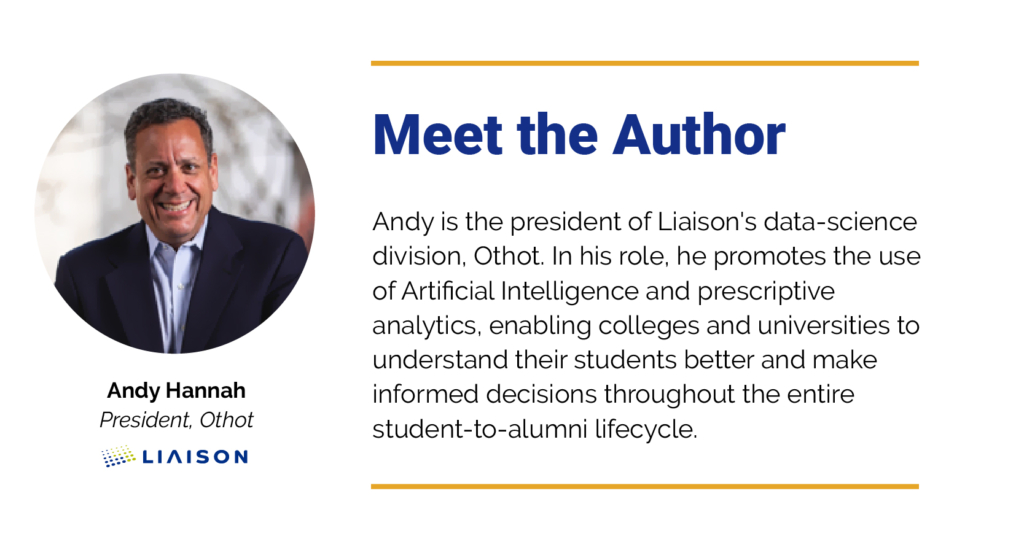In higher education, admissions processes have become the focal point for institutions facing challenges, some anticipated like the demographic cliff, and others, like COVID, unforeseen. The continued evolution of artificial intelligence (AI) and its implementation within higher education is now being used to address, anticipate, and mitigate these and some of the biggest issues college and university leaders are facing. As we evaluate the state of higher education, it becomes evident that the future of admissions lies in the dynamic fusion of traditional wisdom and innovative strategies.
This article explores the intersection of advanced analytics and AI within the context of holistic admissions, shedding light on how emerging technologies are transforming the way institutions select their incoming cohorts to ensure both student and institutional success.
A More Complicated Admissions Landscape Requires New Skills and Tools
Higher education has always been characterized by resilience and adaptability, but recent demographic shifts and the pandemic have prompted institutions to reevaluate their admissions processes. The demographic cliff, marked by declining birth rates, and the pandemic’s consequences have driven a paradigm shift in higher education, emphasizing the need for forward-thinking approaches.
While earlier predictions indicated a 15% decline in college enrollments due to decreasing birth rates, recent data revises this estimate to a 10% decline but is complicated by students and their families questioning the value, timing, and best mode of higher education. Thus, institutions must still adapt to changing demographics. Additionally, the pandemic’s uncertainties, test-optional admissions policies, and evolving perceptions of the necessity of higher education have challenged leaders to forecast the admissions landscape. Institutions must adopt a more holistic approach to admissions to remain competitive and responsive.
What is Holistic Admissions?
Holistic admissions, a term sometimes associated with considering non-cognitive variables when evaluating applicants, has gained prominence among a growing number of institutions. Beyond just academic qualifications, colleges and universities are now looking at a broader set of attributes, including values, experiences, and personal qualities. Holistic admissions can lead to better mission alignment, improved student success, and the enhancement of the educational experience. Yet, challenges exist.
One major challenge is the absence of a standardized framework. Institutions often struggle to define the specific non-academic attributes they wish to consider, and there is no one-size-fits-all approach. Scalability is another issue, as manually evaluating candidates holistically can be time-consuming and resource intensive. Additionally, many institutions are bound by traditional benchmarks like grade point averages and standardized test scores, making it difficult to shift the collective institutional mindset to a more holistic approach.
How Advanced Analytics and AI Can Enable Holistic Admissions
To address these challenges, many institutions are turning to advanced analytics and AI. These technologies and tools help to quantify holistic attributes and create a standardized methodology for a more comprehensive approach. Analytics can help institutions identify which qualities are essential for their specific mission and goals, providing a configurable framework for
evaluation. Here’s how.
| Scalable Framework | Assess non-academic attributes consistently across a large applicant pool, ensuring standardized evaluation. |
| Objective Assessment | Evaluate applicants based on institution-defined critera, reducing the risk for subjective bias |
| Data and Insights-Drive Decision Mking | Establish clear benchmarks for holistic admissions criteria by identifying relationships between attributes and enrollment outcomes. |
| Quantitative Metrics | Compare applicants objectively by assigning scores or probabilities to non-academic attributes. |
| Consistency Among Evaluators | Provide clear guidelines and standardized criteria to align assessments and ensure consistency in evaluations. |
| Customized Criteria | Ensure that the evaluation remains holistic while aligning criteria with your institution’s mission and goals. |
| Real-Time Insights | Provide admissions teams with the opportunity to see the strengths, weaknesses, and holistic attributes of candidates. |
| Bias Mitigation | Promote fairness and equity by removing human bias. |
| Continuous Improvement | Refine holistic criteria over time to enhance the admissions process. |
AI standardizes holistic admissions by providing a systematic, data-driven, and scalable approach to evaluating non-academic attributes. It helps institutions assess applicants consistently, identify patterns and trends, and make informed decisions while promoting fairness and equity in the admissions process.
Holistic Application Through the Enrollment Funnel
The admissions process can be visualized and is often represented as a funnel, with prospects entering at the top and consisting of several stages, including awareness, interest, consideration, application, admission, and enrollment. At each stage, institutions employ various strategies to attract, engage, and convert potential students into enrolled ones.
Analytics and machine learning can play a crucial role in managing this funnel effectively. These tools can assist in identifying potential candidates, predicting their likelihood of enrollment, and prescribing actions to increase their chances of matriculating. This approach optimizes resource allocation and enhances yield rates.
This approach also enables institutions to focus on those with the highest potential for enrollment. AI allows institutions to overlay holistic attributes such as perseverance, emotional intelligence, and cultural fit, into the segmentation process. By segmenting candidates based on these attributes, institutions can refine and optimize the three core elements of their admissions strategies:
- Awareness and Interest
In the initial stages of the enrollment funnel, institutions use AI-driven marketing and outreach to raise awareness among prospective students. Machine-learning algorithms analyze data to identify ideal candidates and tailor communication to their preferences and interests.
- Consideration and Application
As prospective students move further into the funnel, institutions leverage predictive analytics to assess the likelihood of each applicant enrolling. By leveraging the data, colleges can prioritize candidates who are more likely to matriculate, optimizing resource allocation.
- Admission and Enrollment
In the final stages, prescriptive analytics come into play. These algorithms provide actionable recommendations to enhance an applicant’s chances of enrollment. Whether it’s personalized financial aid offers or tailored support programs, institutions can fine-tune their approach based on data-driven insights.
Holistic admissions decisions are ultimately made on an individual basis. Advanced analytics provides decision makers with a comprehensive view of each applicant, encompassing both academic and nonacademic attributes. This level of detail enables institutions to make informed decisions that align with their missions and goals. Using these tools, institutions can not only streamline the admissions process but also improve their yield rates and ensure a more diverse and successful incoming cohort.
Conclusion
In an era of shifting demographics, increasing competition, and evolving expectations, holistic admissions have become a cornerstone in higher education. The seamless integration of advanced analytics and machine learning into admissions systems is critical for their effectiveness. Emerging technologies, including advanced analytics, AI, and machine learning, are empowering institutions to embrace holistic admissions while streamlining their processes and improving outcomes. By leveraging these tools, colleges and universities can navigate the challenges of the modern admissions landscape and continue to attract and nurture diverse cohorts, of students, ultimately fulfilling their missions and achieving their goals.


